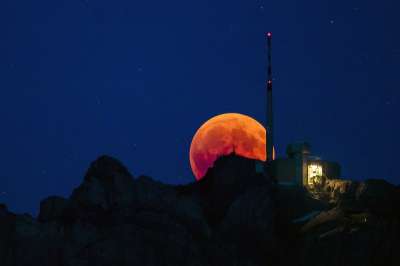In Pics: Resplendent scenes of 21st century's longest total lunar eclipse, Blood Moon 2018
-
 Image Source : AP
Image Source : APFor over six hours, stargazers and common across the world witnessed a spectacular celestial phenomenon - the Blood Moon 2018, the longest total lunar eclipse of the 21st century on the night of July 27-28 (Picture from Switzerland)
-
Image Source : AP
Blood Moon or Total Lunar eclipse occurs when the moon glows a deep red colour due to sunlight scattering. As there is no direct sunlight hitting the moon during an eclipse, all of the light which reaches the moon and bounces back to Earth is indirect (Picture from Dresden, Germany)
-
Image Source : AP
The first part of the lunar eclipse saw the Moon fall under the Earth’s shadow. This part of the eclipse is known as the penumbral eclipse, as the Moon is under partial influence of the shadow cast by the Earth also called Umbra. (Picture from Chennai)
-
Image Source : AP
As the Moon continued on its orbit, and pulled away from the Umbra, stargazers noticed another partial lunar eclipse. This picked up from around 2.43 am IST, which was then followed by another penumbral eclipse. While the partial lunar eclipse concluded by 3.49 am, the penumbral eclipse ended by about 4.58 am. (Picture from Rome)
-
Image Source : AP
The indirect light goes through Rayleigh scattering as it passes through Earth's atmosphere. This, in effect, scatters the longer blue and violet wavelengths more than the shorter red and orange wavelengths (Picture from Israel)
-
The reason this lunar eclipse is the longest of the 21st century is because it passes through the center of Earth's shadow, increasing the time in which the moon is blocked from the sun (Picture from Ankara, Turkey)
-
Image Source : AP
The Blood Moon 2018 was majorly seen in the Eastern Hemisphere including Central Asia and Eastern Africa on the night of July 27-28.
-
Image Source : AP
The total lunar eclipse, also featuring the Blood Moon, lasted for a whopping one hour and 43 minutes. This also outstrips the Super Blue Blood Moon combination that occurred in January of this year by nearly three-quarters of an hour.
-
After witnessing this celestial treat of Blood Moon, India will witness the next lunar eclipse on December 31, 2028 (Picture from Bernkastel-Kues, Germany)